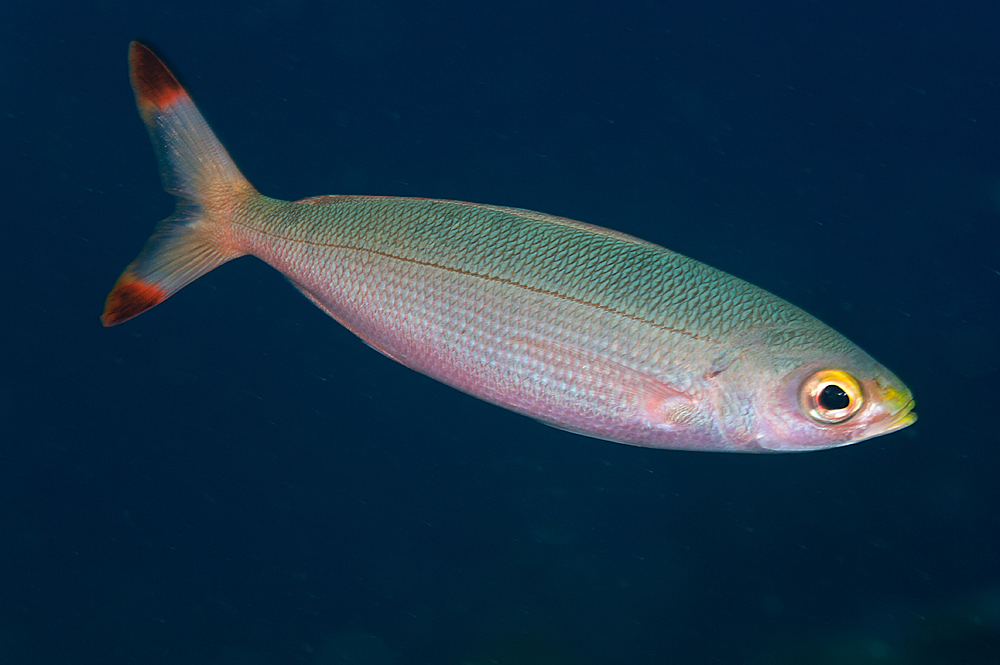Banana Fusilier, Pterocaesio pisang (Bleeker 1853)
Other Names: Ruddy Fusilier

A Banana Fusilier, Pterocaesio pisang, at north Bali, Indonesia. Source: Jim Greenfield / FishBase. License: All rights reserved
Summary:
A silvery bluish-green to reddish fusilier becoming paler below, with a darker lateral line, often a yellowish snout and eyes, and prominent blackish to reddish-black caudal-fin tips.
Cite this page as:
Bray, D.J. 2019, Pterocaesio pisang in Fishes of Australia, accessed 19 Apr 2024, https://fishesofaustralia.net.au/home/species/909
Banana Fusilier, Pterocaesio pisang (Bleeker 1853)
More Info
|
Distribution |
Scott Reef, Western Australia, and Ashmore Reef, Timor Sea, and the northern Great Barrier Reef to off Tully, Queensland. Elsewhere the species occurs in the tropical, Indo-west Pacific. Forms schools around coastal, lagoon and seaward reefs, feeding on zooplankton in the water column. |
|
Features |
Dorsal fin X, 14-16; Anal fin III, 11-13; Pectoral fin 18-20; Lateral-line scales 63-71; Cheek scales 4-5; Predorsal scales 21-29; Upper peduncular scale rows 10-12; Lower peduncular scale rows usually 13-17. Body depth 3.6-4.8 in SL; head length 3.0-3.5 in SL. Ventrolateral surface of basioccipital with a broad process for attachment of Baudelot's ligament. Post maxillary with 2 processes; posterior end of maxilla tapered. |
|
Fisheries |
The Banana Fusilier is heavily fished in parts of its range and has experienced dramatic population declines in some areas. |
|
Species Citation |
Caesio pisang Bleeker 1853, Natuurkundig Tijdschrift voor Nederlandsch Indië 4: 113. Type locality: Ambon Island, Moluccas Islands and Jakarta (as Batavia), Java, Indonesia. |
|
Author |
Bray, D.J. 2019 |
|
Resources |
Banana Fusilier, Pterocaesio pisang (Bleeker 1853)
References
Allen, G.R. 1997. Marine Fishes of Tropical Australia and South-east Asia. Perth : Western Australian Museum 292 pp. 106 pls.
Allen, G.R. & Erdmann, M.V. 2012. Reef fishes of the East Indies. Perth : Tropical Reef Research 3 vols, 1260 pp.
Bleeker, P. 1853. Derde bijdrage tot de kennis der ichthyologische fauna van Amboina. Natuurkundig Tijdschrift voor Nederlandsch Indië 4: 91-130 Ref at BHL
Carpenter, K.E. 1987. Revision of the Indo-Pacific fish family Caesionidae (Lutjanoidea), with descriptions of five new species. Indo-Pacific Fishes 15: 1-56 figs 1-10, pls 1-7
Carpenter, K.E. 1988. FAO Species Catalogue. Fusilier fishes of the World. An annotated and illustrated catalogue of caesionid species known to date. FAO Fisheries Synopsis No. 125, Vol. 8. Rome : FAO 75 pp.
Carpenter, K.E. 2001. Caesionidae. pp. 2919-2941 in Carpenter, K.E. & Niem, V.H. (eds). The Living Marine Resources of the Western Central Pacific. FAO Species Identification Guide for Fisheries Purposes. Rome : FAO Vol. 5 2791-3379 pp.
Carpenter, K.E., Lawrence, A. & Myers, R. 2016. Pterocaesio pisang. The IUCN Red List of Threatened Species 2016: e.T20252870A65927644. http://dx.doi.org/10.2305/IUCN.UK.2016-3.RLTS.T20252870A65927644.en. Downloaded on 04 February 2019.
Hutchins, J.B. 2001. Biodiversity of shallow reef fish assemblages in Western Australia using a rapid censusing technique. Records of the Western Australian Museum 20: 247-270
Randall, J.E. 2005. Reef and shore fishes of the South Pacific. New Caledonia to Tahiti and the Pitcairn Islands. Honolulu : University of Hawaii Press 707 pp.






